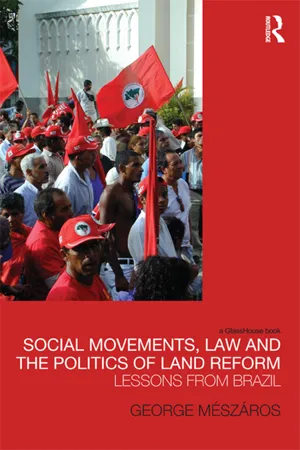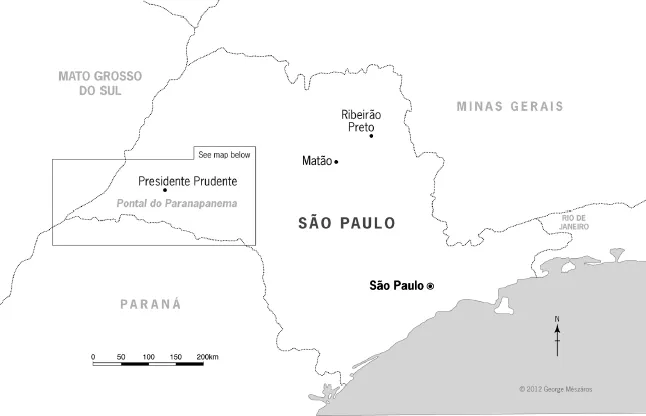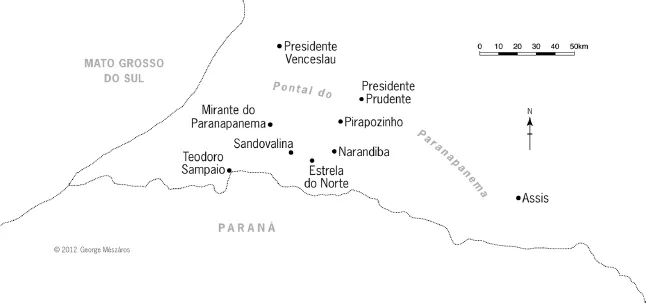![]()
Chapter 1
Shocking the System
Social Movement Pressure as the Catalyst of Political and Legal Change
When we took office there were high court sentences which said that parts of the land occupied by private individuals or groups belonged to the state. This was a big problem for us because it was in precisely these areas that there were invasions [occupations by the MST]. And the invasions in the state of São Paulo, at least at the time, were not merely an issue for the police or the agrarian question; it was a question of justice. They drew attention towards lands that belonged to the state and the state did not take measures. This was the great drama.
Belisário dos Santos Júnior, Secretary of State for Justice, São Paulo 1
While land conflicts across the globe vary in nature, reflecting local social structures and unique histories, a theme that is common to all is a belief that embedded injustices should be righted. Brazil is no exception. In the Pontal do Paranapanema, a region in the west of the state of São Paulo, for most of the nineteenth and twentieth centuries the authorities turned a blind eye to – or colluded in – the theft by powerful private interests of hundreds of thousands of hectares of state-owned land. During the 1990s, however, the forces underpinning these entrenched grievances were overcome to a sufficient extent to lead one of Brazil's foremost land reform exponents to describe events as ‘the closest thing to agrarian reform’ he had seen. 2 Significant though these events were on a regional level, they also raise a wider question of why here and not elsewhere? Of note too is how consistently impotent law had proved throughout the decades. A case in point is a 1958 court ruling that declared these lands the state's. This chapter examines law's wider failure, but also traces how, why and to what extent that changed in the 1990s. Undoubtedly the crucial variable was the development of the Landless Workers’ Movement (MST) as an effective social and political force. The contingency of law is examined here in the context of the MST's rise to prominence. The chapter also touches upon the extent and limits of the movement's own power. In so doing fundamental questions are raised about role of the state, law and social movements in perpetuating and addressing situations of historic injustice.
Property Is Theft: A Brief History of the Pontal do Paranapanema
Long regarded as an economic backwater, the Pontal do Paranapanema is a vast semi-arid region of almost 1.2 million hectares on the most westerly fringe of the state of São Paulo, bordering the states of Mato Grosso do Sul and Paraná (see Figures 2 and 3). Appearances can be deceptive, however, for the region has undergone immense environmental and social changes. In a matter of a few decades a pristine sea-green landscape, the Mata Atlântica, or Atlantic rainforest, has given way to a desert of sandy browns. Commencing in the nineteenth century, the process of destruction persisted with accelerated intensity during the course of the twentieth. According to the São Paulo State Forestry Institute (Instituto Florestal – IF) for instance, in 1971–73 the region still possessed 203,650 hectares of natural vegetation, but by 1990–92 this had dropped to 94,448 hectares, a decline of 54 per cent. 3
Alongside the incipient forestry clearance of the 1850s went the slaughter and complete liquidation of the indigenous inhabitants, including the Kaiuás and Kaingang. 4 One graphic account of the time noted that
On meeting female Indians some were imprisoned and others killed. The same, it is said, happened to the men who were raised from their beds or from the floor, thrown in the air and impaled on the tips of knives; on other occasions they were held by their feet and their heads smashed apart on wood. The wombs of pregnant women were sliced open and, after the carnage, the bodies were piled high and set alight. 5
Figure 2 Map of São Paulo State showing location of Pontal do Paranapanema
Figure 3 Map of Pontal do Paranapanema
Cotton, coffee and subsequently cattle would take their place. Out of these destructive processes there emerged a new regional social order of large landed estates whose self-proclaimed owners would retain a tenacious grip on political and economic power well into the 1990s. Predatory speculation played a decisive role in the region's development. Although early phases of the colonisation exhibited semi-spontaneous characteristics associated with a land grab, as thousands of small settlers and squatters were enticed into the region with promises of land in exchange for labour, the venture was in fact hierarchically structured and ruthlessly controlled. Little did these settlers realise that they were merely the foot soldiers for grander, utterly fraudulent claims. Once they became surplus to requirements, they were simply evicted at gunpoint or executed by hired gunmen. Conversely, for the tiny handful of individuals at the top of this system, the genocide of Indians, the destruction of forests and subsequent wholesale clearance of squatters and sharecroppers offered massive rewards, leading one powerful landowner to declare that ‘land soaked in blood is good land’. 6
The 1850 Land Law and its Legacy
What did the law have to say about these seemingly chaotic developments? In theory, with the passage on 18 September 1850 of the Lei de Terras (Law 601, basic legislation governing the use and appropriation of land throughout Brazil), the answer is a great deal. This law had asserted that devolved lands – tracts of land that did not as yet belong to private parties – could no longer be appropriated except through means of purchases made directly from the government.7 Article 1 asserted that ‘[t]he acquisition of devolved lands by title other than purchase is hereby prohibited.’ As noted in the Introduction:
[it] would transform devolved lands into a monopoly of the state and a state controlled by a strong class of large landowners. The non-propertied peasants, those that arrived after the Lei de Terras or those that had not had their occupations legalised in 1850, were therefore compelled … to work for the large estates. 8
Thus the law attempted to manage the transition from a slave economy to a capitalist one, deliberately locking millions – whether freed slaves, smallholders or immigrants – out of landownership and into waged employment on large estates.
As in many other parts of Brazil, the development of property relations in the Pontal do Paranapanema highlights the state's consistent failure, despite the Lei de Terras, to exercise any meaningful sort of control over devolved lands facing predatory interests. This has not changed even with the superimposition of legislation after 1850. Although the concept of devolved land was incorporated (with some variations) in Brazil's first republican constitution of 1891 and reasserted in the constitution of 1988, the Lei de Terras remains a fundamental reference point.
The connections between past and present, and their practical implications, are summarised by Pressburger as follows:
The Lei de Terras of 1850 and its regulations determined how, under what conditions, and for how much devolved lands could be sold to private individuals. Later, other laws regulated the alienation of public lands and, more recently, (Decree-Law 900 of 29/6/1969) established a whole framework of authorisation by legislative power, public competition, etc. Thus, in every analysis of title to private property an investigation is essential so as to determine its origins, that is to say, to check if it is not in fact devolved land (public) ‘transformed’ into private property and, if the latter proves to be the case, what the legislation was that authorised this ‘transformation’, and whether all the requisites of that legislation were correctly and fully attended to. That is because if the privatisation of the public asset was not realised in accordance with the legislation then in legal terms the asset remained inalienable and, as established in the Civil Code, beyond commercialisation. 9
Manifestly the legal requisites to which Pressburger refers were not attended to in the Pontal do Paranapanema (a fact that would later be used by the MST to legitimise its own claims). Instead, landownership in the Pontal was predicated upon an industry of deception.
There are numerous accounts of the illegal transfer of devolved land into private property. A glaring example of this occurred in 1856 when Antônio José de Gouvêa falsely laid claim to 300,000 hectares in the Pontal. His documentation asserting knowledge and ownership included an entirely fictitious river, the Pirapó. He claimed to have been living and farming near there before 1848. Fearing imminent legal action, in 1890, Manoel Pereira Goulart, another owner, took the extraordinary step of simply exchanging his own land with that of the successors to the estate of Gouvêa. Theirs was a blatant attempt to create false trails. Goulart's estate lay outside, but bordered, the Pontal. It shared a number of characteristics in common with Gouvêa's estate. It too could be measured in the hundreds of thousands of hectares, was said to have been subject to occupation and cultivation prior to 1850. Both claims to legalisation were based upon fictitious parish records that proved so full of legal and technical inaccuracies that the governors of São Paulo at the time came to reject them. One governor, Visconde de Parnaiba, even sought to prosecute Goulart.
The legal profession, cartographers and corrupt local priests (acting in their capacity as public notaries) were central to the deception. Along with paperwork of varying degrees of sophistication, these pillars of the local establishment generated powerful cultural expectations. Their work possessed a ring of authority and authenticity. A favoured method of falsification was grilagem. The term (which became synonymous with all forms of land acquisition through false title deeds) derived from the word grilo, or cricket, and referred to the practise of locking title deeds in a drawer with crickets. Once they died they secreted liquids which discoloured or aged the documents prematurely. Corrupt notaries then authenticated them.
The factors that led to the development of a fully functioning land market in the Pontal do Paranapanema were complex. Paradoxically the Lei de Terras was partly responsible. It had deliberately engineered wider conditions for the commodification of land and labour. Men like Gouvêa and others were opportunists who saw the loopholes and played them for all they were worth. Crucially, though, their aggressive confidence was combined with an ambiguous response by the state. The latter could never accept his actions since these were a deliberate attempt to circumvent the legislation, hence periodic legal actions, but there was a sense in which Gouvêa and others were doing the state's job for it, i.e., transforming land into a commodity and developing capitalist relations.
It may seem odd that anyone sho...


